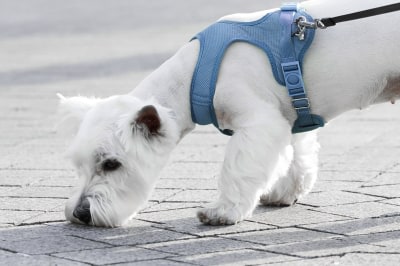Veterinary diagnostic tests are an exceptional tool used by our Oklahoma City veterinarians to help us pinpoint the cause, extent, or seriousness of your pet's illness or injury. Depending on your pet's condition, the type of pet diagnostic test used will vary. Below are a few of the tests that your vet may recommend to help diagnose or treat your dog or cat.
Radiography (X-Rays)
X-rays are an important diagnostic tool in animal laboratory testing. They allow veterinarians to identify issues such as broken bones, bladder stones, swallowed foreign objects, and more. They can also help detect tumors, pregnancy, and enlarged organs, which can lead to heart disease or cancer diagnosis.
Because X-rays do not provide a detailed view of a pet's organs, tissues, or ligaments, other diagnostic imaging techniques, such as MRI and ultrasound, are more useful.
For dogs and cats, X-rays are non-invasive, painless, and considered very safe. They only use very low levels of radiation, and pregnant animals are unaffected. Sedation may be required in some cases to obtain a clear image of the body. If the dog or cat is calm, not in too much pain, and able to lie in a comfortable position, sedation may not be necessary.
Ultrasounds
Ultrasounds are a type of imaging technology used to diagnose or evaluate problems with a pet's internal organs, as well as to check on their pregnancy. They are non-invasive and can be used to detect and treat medical conditions like cysts and tumors.
Ultrasounds on various parts of your pet's body necessitate different preparations. Consult your veterinarian to learn how to prepare your pet for an ultrasound. For abdominal ultrasounds, you may be asked to fast for 8 to 12 hours. When the urinary bladder is full, we can examine it more thoroughly. This is why, if at all possible, your cat or dog should not urinate for 3 to 6 hours before the ultrasound.
The area to be examined will most likely be shaved to produce clear images. While the majority of pets will remain still and cooperative during the ultrasound, some will require sedation.
PET/CT Scans
CT and PET scans necessitate that your pet remain completely still. As a result, your veterinarian will almost certainly administer general anesthesia. The scan is quick, and vital signs are monitored. A specialist interprets the images and sends a detailed report to the veterinarian who is treating the pet.
Computed Tomography - CT Scans
CT scans produce a high-resolution image of a dog or cat's bony and soft tissue structures, such as the spine, nasal cavity, inner ear, bones/joints, and chest/lungs. They can also be used to assess lymph nodes, thyroid glands, abdominal organs, skull/brain structures, and vascular structures.
Positron Emission Tomography - PET Scans
This procedure combines a CT scan with the intravenous (IV) administration of a contrast agent to your pet. This enables veterinarians to see increased blood flow areas in the animal's body. PET scans aid in the detection of cancer and areas of inflammation.
Bloodwork
Before any visible symptoms appear, blood tests can detect the earliest signs of illness. They can help with disease or illness detection, identification, diagnosis, and treatment. Blood tests are also required during routine exams for healthy pets to obtain normal baseline values. Diagnostic blood tests can help your veterinarian determine the cause of your dog's symptoms.
A complete blood count (CBC) and a complete blood chemistry panel, which includes electrolytes and urinalysis, are two commonly used tests to diagnose anemia, inflammation, infection, immune system response, and blood clotting ability. The chemistry panel and electrolytes provide information to your veterinarian about your pet's liver, kidneys, and pancreas. Blood tests can also detect and identify complex issues within the internal systems of a dog, such as hormonal and chemical responses.
Urinalysis
A urinalysis is a simple diagnostic test that determines the physical and chemical properties of urine. It is most commonly used to evaluate the health of the kidneys and urinary system, but it can also reveal problems with other organ systems. Every pet over the age of eight should have a urinalysis once a year. If your pet has increased water intake, increased frequency of urination, or visible blood in the urine, a urinalysis may be recommended.
Fecal Exams
Fecal exams are performed in a veterinarian's office and are used to diagnose and treat a variety of infections that may be threatening your pet's health. Because intestinal parasites can be transmitted to humans, having your pet examined annually protects your family.
Fecal examinations enable veterinarians to identify intestinal parasites such as hookworms and roundworms. These can cause discomfort and irritability in pets, as well as lead to more serious problems. Examining feces is the best way to detect parasites because they can go undetected and infect other pets or people in the home.
Magnetic Resonance Imaging - MRI
MRI has been widely used to help diagnose human health issues since the early 1980s, but veterinary MRIs have only recently become more widely used.
MRI scans can provide high-resolution images of soft tissues like the brain, spinal cord, ligaments, tendons, and abdominal organs to detect injuries and diseases. They are more detailed than other diagnostic imaging tools such as x-rays or CT scans.
If your dog or cat is limping, lame, having seizures, experiencing joint pain, neck pain, back pain, or paralysis, an MRI may be recommended to help diagnose the cause of your pet's symptoms.
MRIs of dogs and cats take 45 minutes to an hour to complete. A general anesthetic is given prior to the scan to ensure success. Before the MRI, veterinarians recommend blood tests and x-rays to ensure the pet is healthy enough to be sedated.
Note: This post is for informational purposes only. Putnam North Animal Hospital is unable to offer CT/PET scans and MRIs at this time.



